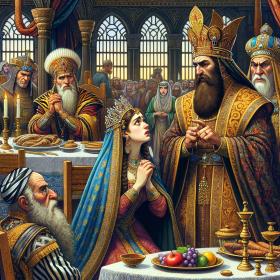Purim-When Order Becomes Chaos and the World Turns Upside Down

Purim-When Order Becomes Chaos and the World Turns Upside Down
Dr. Liron Biran Nisenholz
Imagine a religious holiday where social norms are deliberately upended, where sacred becomes profane, where the powerful become weak, and where celebrants are actually commanded to party. This isn't some hypothetical anthropological thought experiment—it's Purim, one of Judaism's most vibrant and joyous celebrations that has been observed since the second century BCE.
The Epic Narrative Behind the Festival
At its core, Purim commemorates events described in the Book of Esther (the Megillah), set in the Persian Empire around 486-465 BCE. Think of it as a political thriller with plot twists that would make Netflix writers jealous: King Achashverosh (often identified with Xerxes I) executes his wife Vashti when she refuses to be displayed as a trophy at his feast. He then selects Esther, a Jewish woman concealing her religious identity, as his new queen.
Meanwhile, the king's advisor Haman—essentially one of the original prototypes for literary villains throughout history—develops a genocidal vendetta against the Jews after Esther's cousin Mordechai refuses to bow to him. Through a masterclass in political maneuvering, Esther reveals her Jewish identity to the king and exposes Haman's plot. The narrative climaxes with a stunning reversal of fortune: Haman is executed on the very gallows he constructed for Mordechai, and the Jews receive royal authorization to defend themselves against their would-be attackers.
The Original Carnival: Structuring Anti-Structure
What distinguishes Purim from many other religious observances is its deliberate embrace of topsy-turvy logic. Since the Jews' fate was dramatically reversed in the story, everything gets flipped during Purim. Think of it as The Purge, but for social norms rather than laws against violence.
Authority figures become targets of good-natured mockery. The sacred becomes playfully profane. Prohibitions transform into permissions. Social hierarchies temporarily dissolve. This "carnivalesque" quality makes Purim a textbook example of what cultural anthropologists like Victor Turner call "antistructure"—a temporary suspension of normal social order that, paradoxically, helps maintain social cohesion throughout the rest of the year.
In contemporary terms, imagine if we combined elements of Halloween, Mardi Gras, and a political satire show, then added centuries of cultural significance and religious meaning. That begins to approximate what Purim represents in Jewish cultural life.
Purim: A User's Guide
Purim involves four main mitzvot (commandments):
First, hearing the Megillah read aloud—during which participants make noise to symbolically "blot out" Haman's name whenever it's mentioned. Think of it as an interactive Rocky Horror Picture Show experience, but with ancient Persian court intrigue instead of Tim Curry.
Second, feasting and drinking—traditionally to the point where one cannot distinguish between "blessed is Mordechai" and "cursed is Haman." Yes, this is perhaps the only religious holiday where moderate intoxication is actually encouraged. Third, exchanging food gifts (mishloach manot) between friends, creating community bonds through shared culinary experiences.
Fourth, giving charity to those in need, ensuring that celebration includes consideration for the less fortunate.
Beyond these requirements, Purim has developed rich supplementary traditions. Costumes and masquerade allow participants to temporarily embody different identities—making Purim the original cosplay convention. Purim spiels (humorous theatrical performances parodying the Purim story) bring creative reinterpretation to the narrative, with many organizations staging elaborate productions that cleverly transpose the ancient story into contemporary settings. The tradition of crowning a temporary "Purim King/Queen/Rabbi" who assumes brief ceremonial authority reinforces the theme of social inversion. Even cross-dressing represents a rare religious exception to traditional prohibitions, further emphasizing Purim's role as a day when normal rules are suspended.
Culinary Revenge: You Are What (and Whom) You Eat
Purim foods often symbolically "consume" the villain Haman, offering edible historical justice. Hamantaschen (triangular cookies resembling Haman's hat or ears) are perhaps the most widely known, appearing everywhere from artisanal bakeries to university dining halls during the holiday. But Jewish communities worldwide have developed their own deliciously vindictive representations: "Haman's Fingers" (nut-filled pastries from Spanish traditions), "Haman's Eyes" (egg-stuffed breads from Morocco), and "Haman's Teeth" (caramelized dough balls from Egypt) all transform eating into ritual triumph over historical adversity.
This culinary tradition invites intriguing psychological analysis: how does consuming symbols of one's historical oppressors function as collective catharsis? Food becomes more than sustenance—it becomes a medium for historical memory and cultural resilience.
Universal Themes in a Particularistic Holiday
While Purim emerges from specific Jewish historical experience, its themes transcend religious boundaries and speak to universal human conditions:
Community solidarity is fostered as masks and costumes create temporary equality between economically disparate groups—a reminder that social distinctions are often arbitrary constructions.
Feminist perspectives emerge in the celebration of complex female characters. Esther's strategic leadership represents one model of female power, while Vashti's refusal to be objectified has been reclaimed by feminist thinkers as an early example of resistance to patriarchal demands. Their contrasting approaches to power present a nuanced view of feminine agency that remains relevant in contemporary discussions of gender politics.
Identity politics avant la lettre appear in Esther's complex navigation of her concealed and revealed identities—a narrative that resonates with anyone who has experienced the challenges of being "other" within dominant cultural structures. Her story raises questions about assimilation, cultural preservation, and when to reveal or conceal central aspects of oneself.
Resilience through humor demonstrates how comedy becomes a powerful tool for confronting historical trauma—a psychological strategy employed by many marginalized groups throughout history.
Fascinatingly, Purim falls exactly one month before Passover in the Jewish calendar. While Purim represents controlled chaos and the suspension of normal rules, Passover embodies law, structure, and historical order. This timing suggests an important psychological pattern: sometimes we need to embrace antistructure to fully appreciate and maintain structure in our lives—a lesson particularly relevant to university students navigating the tensions between academic discipline and collegiate revelry.
Whether one observes Purim religiously, culturally, or are simply learning about it academically, its central message offers profound insight: sometimes the most serious challenges require us to embrace joy, humor, and a willingness to see the world differently—if only for a day. In a world often characterized by rigid ideological positions, Purim reminds us of the value of occasionally turning everything upside down to gain new perspective.
Last Updated Date : 29/04/2025



